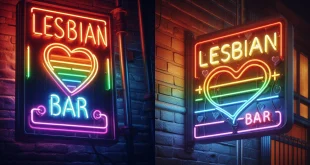Lesbian literature includes works by lesbian authors, as well as lesbian-themed works by heterosexual authors. Even works by lesbian writers that do not deal with lesbian themes are still often considered lesbian literature.
The first novel in the English language recognised as having a lesbian theme is Radclyffe Hall’s The Well of Loneliness (1928), which a British court found obscene because it defended “unnatural practices between women”. The book was banned in Britain for decades; this is in the context of the similar censorship of Lady Chatterley’s Lover, which also had a theme of transgressive female sexuality, albeit heterosexual.
Lesbian fiction saw a huge explosion in interest with the advent of the dime-store or pulp fiction novel. Lesbian pulp fiction became its own category of fiction, although a significant number of authors of this genre were men using either a male or female pen name. The feminist movement in the late 1960s and early 1970s saw a more accepted entry of lesbian-themed literature.
Of course, the patron saint of Lesbian literature is the ancient greek poet Sappho Of Lesbos, despite the fact that within her works descriptions of physical acts between women are few and subject to debate. What is not in question, though, is that her existing works constitute a body of work of major importance within literature. The word lesbian derives from the name of the island of her birth, Lesbos, while her name is also the origin of the word sapphic; although both words were only applied to female homosexuality beginning in the 19th century.
Orlando by Virginia Woolf, while not directly dealing with being a lesbian, is widely held to be ground breaking in its depiction of gender issues. Elsewhere among the classics you’ll find Frank Marcus’ 1963 play The Killing of Sister George. Marcus intended the play to be a farce, not a serious treatment of lesbianism, but because there was so little material about lesbians it became treated as such. A memoir which deals directly with lesbianism is The Autobiography of Alice B. Toklas by Gertrude Stein, which is one of Stein’s more accessible works.
Within modern fiction there are many more books dealing with lesbian issues, reflecting changes within society’s attitudes. The Color Purple by Alice Walker; Oranges Are Not the Only Fruit by Jeanette Winterson; and Rita Mae Brown’ Rubyfruit Jungle are all good places to start. There are also a great number of contemporary lesbian mysteries – this genre is often more welcoming to sexual minorities. Contemporary Lesbian Romances are typified by the novels from Karin Kallmaker, Radclyffe; while lesbian science fiction works frequently address the issue of feminist/lesbian separatist communities.
 Lesbian, Gay, Bisexual, Transgender & Intersex News Lesbian News, Gay News, Bisexual News, Transgender News, Intersex News, LGBTI News
Lesbian, Gay, Bisexual, Transgender & Intersex News Lesbian News, Gay News, Bisexual News, Transgender News, Intersex News, LGBTI News




